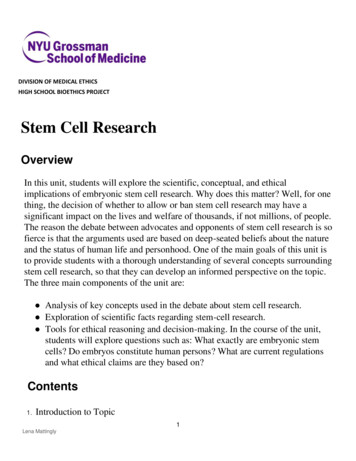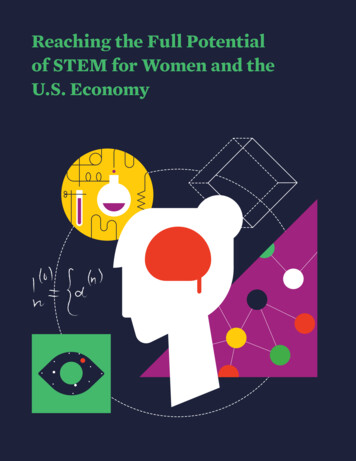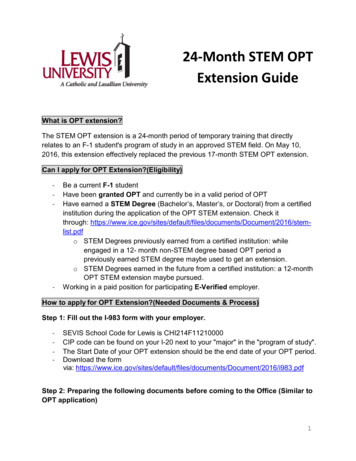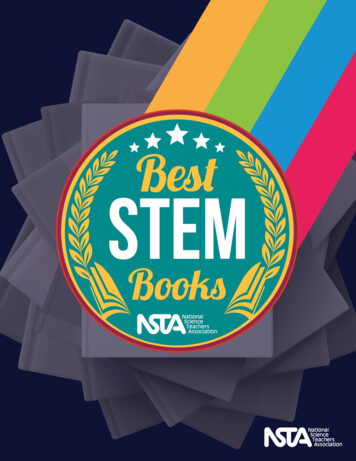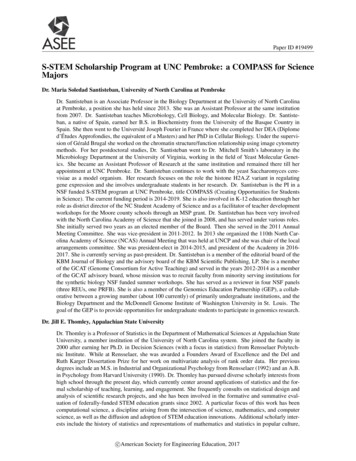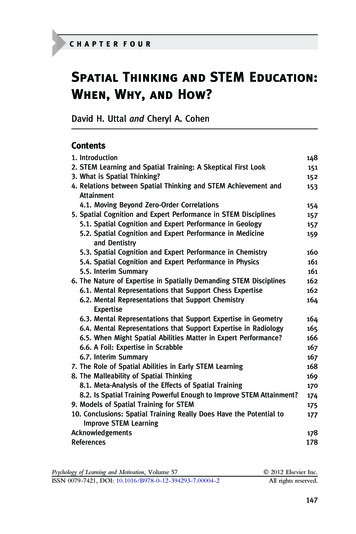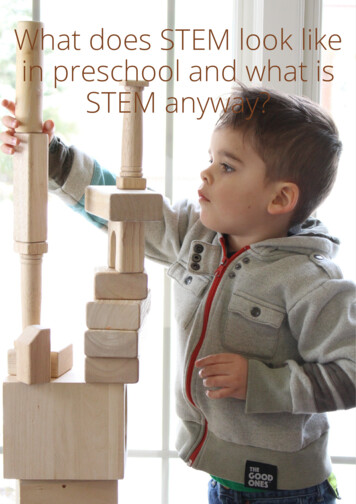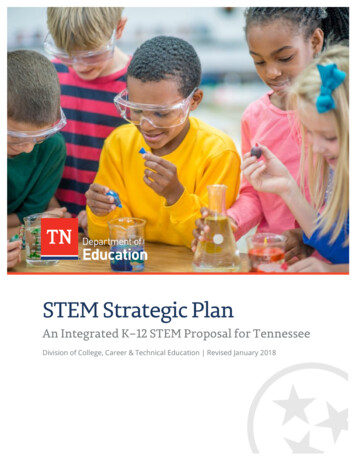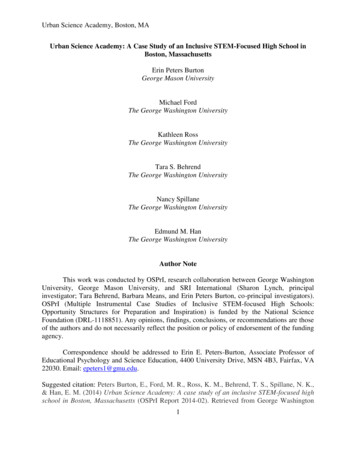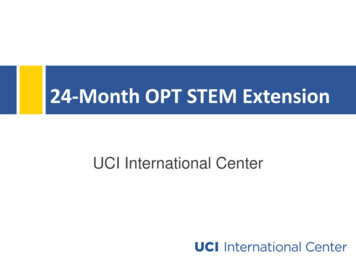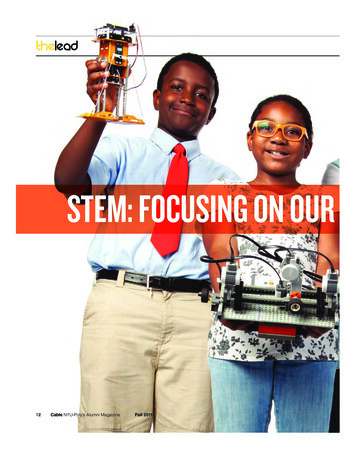
Transcription
theleadSTEM: FOCUSING ON OUR F12Cable NYU-Poly’s Alumni MagazineFall 2011
NYU-Poly graduate fellows mentor 16 FIRSTLEGO League teams in Brooklyn.R FUTUREPOLY.EDU / CABLEStudents Malik Bailey, Theory Cogbill andHieu Hoang are taught by NYU-Poly’sDr. Vikram Kapila, Jennifer Haghpanah,Jasmin Hume and Andrew Cave.Cable NYU-Poly’s Alumni MagazineFall 201113
Dr. Vikram Kapila (below left) is a principal investigatorof the Central Brooklyn STEM Initiative."WHAT NEEDS TO HAPPEN AT A NATIONAL LEVEL IS HAPPENING ON A SMALL SCALE HERE, WITH14Cable NYU-Poly’s Alumni MagazineFall 2011P
ITHtheleadPILOT PROGRAMS LEADING TO A MUCH RICHER, MUCH DEEPER PROFESSIONAL DEVELOPMENT"-Vikram Kapila, professorA 21st century education requires much more than the classicthree Rs. In order to keep pace with the ever-evolving technologicalarena, every child, from pre-K through high school, must haveSTEM (Science, Technology, Engineering and Mathematics)education as the cornerstone of their educational experience.Unfortunately, the reality of our educational system is verydifferent and as a result inadequate academic preparation closespeople out of scientific careers at a young age, even thoughPOLY.EDU / CABLEour 21st century economy depends on people well-trained inthese subjects.Another issue: good education costs money. “Some say youcan deliver it on the cheap, but is that any great service to thestudents?” asks Vikram Kapila, professor, Mechanical andAerospace Engineering, who has been involved in many STEMprojects at NYU-Poly. “Students need to experience science theway scientists do.”Cable NYU-Poly’s Alumni MagazineFall 201115
theleadProgress at PolyLong before President Obama launched his Educate to Innovateinitiative in January 2010 to boost STEM education, NYU-Polyfaculty, graduate researchers and undergraduate students werecollaborating to improve teacher preparation in STEM disciplines.For close to a decade, with the support of federal, state andfoundation grants, a variety of programs have provided professionaldevelopment for elementary, middle and high school teachers; putNYU-Poly engineering students in classrooms to co-teach; andgiven children science experiences that prepare them to be able tochoose a STEM career.Kapila has just completed the third year of the SMART(Science and Mechatronics Aided Research for Teachers) project,which educates teachers on using robotics-based lessons andNYU-Poly STEMulus project introducedunderprivileged high school students tonew science topics and technology.activities. He has also brought middle and high school teachers toNYU-Poly, and sent NYU-Poly students to teach in city highschools. He had high school students performing summerresearch alongside graduate and undergrad students, in a programcalled YES (Youth in Engineering and Science). “What needs tohappen at a national level is happening on a small scale here, withpilot programs leading to a much richer, much deeper professionaldevelopment program,” he says.Another NYU-Poly effort last summer was the STEMulus Project,a four-week life-sciences course for a dozen high school studentsfrom the Urban Assembly Institute for Math and Science for YoungWomen, which serves mostly underprivileged students. Coveringbiology, chemistry and technology on the topics of cancer,diabetes and HIV/AIDS, it was designed and taught by threeNYU-Poly graduate students under the direction of Jin KimMontclare, assistant professor, Chemical and Biological Sciences.“They were exposed to technology they wouldn’t otherwisehave access to,” says Montclare. “My grad students learned a lot,too. Being in the classroom compelled them to learn how tohandle a group of students and how to teach.”16Cable NYU-Poly’s Alumni MagazineFall 2011NYU-Poly’s Cybersecurity Awareness Week (CSAW) competitionis a nationwide forensics challenge for high school students.Using digital evidence, such as a broken USB stick, they extract datain order to solve a murder mystery. “We were amazed how good thekids were—they solved challenges we didn’t expect them to,” says
NYU-Poly’s Central Brooklyn STEM Initiativepairs local teachers with graduate fellows.President Obama’s “Educate to Innovate” campaignwas launched in 2010 to increase STEM literacy.Maurizio Porfiri, associate professor, Mechanical and Aerospace Engineering, is involved in a number of K-12 outreachefforts. He recently supervised a program at the New York Aquarium, which mixed the aquarium’s animals with state-of-the-art,bio-inspired robotics for “a fun science day, where elementaryand middle school students were exposed to fundamentals offish swimming and robotics, then designed a fish tail to propel arobotic fish,” he says. In addition, every year his laboratory hoststwo teachers to work on research projects in underwater mechatronics; his students in turn take their research experience andleadership into the classroom.A Fellows program sends NYU-Poly graduate students into cityclassrooms every year. This year 14 Fellows will go to 23 schoolsThe Mechanical Engineering Lab at NYU-Polyis always filled with robots of every shape,size and function—even camera-equippediPad and iPhone controlled ones (top).Nasir Memon, professor, of Computer Science and Engineering.“You make it exciting enough and they’ll do it, especially if we canprovide resources and companies that will sponsor and mentor localschools.” A fun challenge like this is also a way to attract girls andstudents who may not normally be inclined to science, he adds.POLY.EDU / CABLEin Brooklyn, where they will work with 2,000 to 3,000 kids, inclassrooms with the Fellows or in after-school robotics. “We hopeto be in 36 schools by next year, and eventually, 50 to 75,” saysBen Esner, director of K-12 STEM Education at NYU-Poly.Esner would like to see preschool kids getting STEM ed, too.“No child is too young to do science,” he says. “We’re working ona project that involves a preschool. Four-year-olds like to knockthings over, so we do physics.”Esner has also applied for a Change-Maker Award from theAshoka Foundation with a proposal to involve industry professionals in STEM education. “Our grads leave NYU-Poly makingmore than 60,000 in their first job. They’re unlikely to becomeK-12 teachers, because their long-term earning potential is sohigh,” he points out. “How then do we get a STEM professionalto teach? I’d like them to feel they have an obligation to teach ormentor as part of their career path. More near-term, we are tryingto build partnerships with industry to release their employees intoschools for a couple of weeks a year.”Cable NYU-Poly’s Alumni MagazineFall 201117
Ben Esner, director of K-12 STEM Education at NYU-Poly. Esner would like to see preschool kids getting STEM ed, too. ÒNo child is too young to do science,Ó he says. ÒWeÕre working on a project that involves a preschool. Four-year-olds like to knock things over, so we do physics.Ó Esner has also applied for a Change-Maker Award from the
